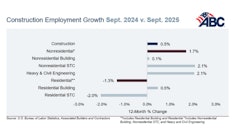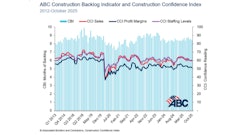
As the construction industry enters the second half of 2025, one trend is becoming increasingly clear: contractor qualification is becoming a central pillar of how project owners manage risk, verify readiness and meet rising insurance expectations.
With contractors making up a growing share of the active workforce on commercial and industrial job sites, clients must ensure that every individual stepping onto their site is qualified, trained and appropriately insured for the job at hand. That expectation is essential to safe operations and business continuity.
A Shift Toward Accountability
The broader shift across industries has been from compliance to accountability. In the past, many safety programs focused on meeting OSHA or other regulatory requirements. Compliance was the benchmark. But over the past few years, there’s been a notable change in mindset.
Owners, general contractors, and insurance providers are now more focused on real-world outcomes, including fewer injuries, more precise controls and job-site specific safety results. That has changed how contractor qualification is viewed. It’s no longer sufficient to maintain generic pre-qualification files in a database. Stakeholders want to see current documentation, tied to the specific work being performed, and updated as conditions change.
As of 2023, Cahill Tech reports more than 70% of construction firms still rely on paper-based processes to manage safety and qualification, despite strong evidence that digital tools reduce risk and improve efficiency. That gap between what’s needed and what’s in place is a key vulnerability.
What Today’s Qualification Process Needs to Deliver
Contractor qualification in 2025 involves far more than checking a box. Owners expect:
- Real-time data verification, including certificates of insurance (COIs), EMR, TRIR, site-specific safety plans and safety handbooks
- Work-specific vetting, qualifications aligned with the hazards and scope of the actual job
- Site-specific training records, confirmation that employees have been trained on the risks unique to the facility or project site
- Ongoing visibility with the ability to verify who’s compliant at any given moment
This requires coordination between safety teams, project managers, procurement staff and the contractors themselves. In many cases, it also requires digital tools to streamline and centralize what used to be scattered across email chains, spreadsheets or outdated platforms.
The Problem with One-Size-Fits-All
Many safety managers are still managing contractor documentation manually or using overly rigid systems that don’t adapt well to different project types. These platforms often apply the same standard to every contractor, regardless of whether they’re painting a hallway or operating cranes.
When qualification requirements are misaligned with job scope, two problems arise:
- Overburdening contractors with irrelevant requirements, leading to poor participation and pushback
- Missing critical data when specific, higher-risk roles aren’t vetted thoroughly enough
It’s also common for safety teams to lose valuable time chasing down expired documents, re-verifying the same contractors, or managing conflicting information between systems. This administrative overhead distracts from higher-value safety work and delays onboarding, especially on fast-moving projects.
Why Timing and Visibility Matter
The real pain point in contractor qualification today is timing. Many facilities and job sites don’t discover that a contractor lacks valid insurance or hasn’t completed the required training until the crew arrives at the gate. By then, it’s too late. Either the project is delayed while paperwork is sorted, or the site assumes risk by letting unqualified personnel in.
That’s why real-time status visibility is becoming non-negotiable. Hiring clients want to quickly see who is fully qualified and who isn’t. They also want an easy way to update requirements based on evolving site conditions or changes in work scope.
Training Must Be Part of the Process
Another critical evolution in 2025 is the integration of training into contractor qualification. Historically, qualification was about documents, while training was handled separately. That gap often led to issues where a contractor was technically qualified but unfamiliar with the specific hazards or protocols of a site.
Today, more owners are tying site-specific training directly into the pre-qualification workflow. Contractors must not only upload documents, but they must also have employees complete training modules customized to the location and work being performed.
This integration creates value on multiple fronts:
- Contractors show up better prepared and aligned with safety expectations
- Safety teams reduce the time spent onboarding new crews
- Owners gain confidence that compliance is built into the culture
And this investment pays off. A recent Dodge Construction Network study found that 78% of contractors who invested in structured safety programs received better insurance terms, while 66% saw improved performance from their trade partners and 61% noted higher worker retention.
Where the Industry Is Headed
As insurance markets continue to tighten and safety expectations rise, contractor qualifications will only grow in importance. The companies that succeed in this landscape won’t just collect paperwork; they’ll build qualification systems that are scalable, role-specific and seamlessly integrated with training.
At the same time, safety professionals will need tools that simplify this process, not add to the complexity. The goal isn’t more software. The goal is clarity: knowing who’s qualified, who’s trained, and who’s ready to work, without wasting hours tracking it down.
What Safety Leaders Should Focus on Now
If you manage contractor safety or oversee pre-qualification for a construction project or industrial site, now is the time to evaluate your current system.
Ask the following:
- Are we tailoring requirements to the type of work being performed?
- Can we verify qualifications and training in real time, without extra steps?
- Do our systems help us reduce risk, or just collect paperwork?
Contractor pre-qualification is becoming a critical control in overall site safety. It affects everything from incident rates to insurance premiums to project scheduling.
Final Thoughts
In our work supporting industrial and construction safety teams, we’ve seen firsthand how qualification processes are maturing. Companies want accountability, not just checklists. They want streamlined systems, not an administrative burden. Most importantly, they want contractors on site who are truly prepared to do the work safely, confidently, and in compliance.
If you’re leading safety in 2025, contractor qualification is one of the most critical systems you can improve.




















